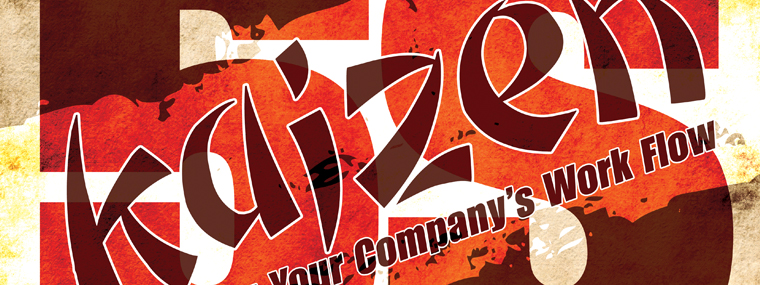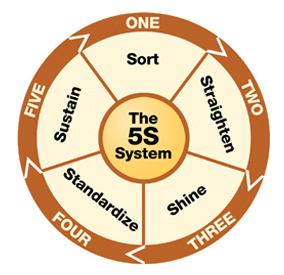
Kaizen: Improving Your Company’s Work Flow
By Jeffrey Paulding and Patricia Zermo-Webb / Published December 2013

Kaizen is a Japanese word meaning “improvement” or “change for the best.” Here in America, kaizen is associated with quality management practices and has now taken on the meaning of “continual improvement.” At our company, we use kaizen to mean improving the way we do things; often, we turn it into a verb, such as, “we are going to kaizen the chemical room.” It is all part of a larger effort of our company and our affiliate, Hamilton Associates, to incorporate the best practices of Lean Management and ISO 9001 into our company operations.
Kaizen and Lean Management concepts stem from the Toyota Production System (TPS) developed by the Toyota Corporation after World War II. Many of the ideas that are central to TPS, such as just-in-time inventory control, have now been integrated in the manufacturing of companies throughout the world and have become familiar to the general public. Other ideas such as autonomation—intelligent automation—the “elimination of waste,” or “flow,” where manufacturing is based upon product “pull” rather than a top down production plan, are all part of the Lean Management philosophy or TPS. It all gets complicated pretty quickly. But at the end of the day, what we are looking for is improvement or kaizen. The basic idea of kaizen is to make the job easier and more efficient for both the employee and employer.
From my perspective, there are two fundamentals to making kaizen work: support from management and buy-in from the employees. After all, patterns of work are just habits that we have developed in the workplace for various reasons: “it is the way we have always done it,” “it is the best way,” “it is the way I was taught to do it,” and “the boss likes it done this way.” We usually do things the same way day in and day out without giving it too much thought, saving our imagination for what we are going to do Saturday night. Implementing a kaizen process begins by developing a questioning attitude toward our work and continually looking for ways to improve. Resistance to change can come from anywhere, but it is most frequently found at the top where the boss is convinced that his or her way is the “best” way, and at the bottom, by employees who would rather just be left alone. So to begin the kaizen process, you need all employees in the organization on board, from the Big Chief to the Indians.
At Dirt Killer, we had a series of meetings and watched a few videos that explained the process and gave us the basic concepts. We were also assisted by outside consultants who were familiar with the various tools that are frequently used to generate new ways of looking at old work patterns. Lastly, we were motivated by our need to get a lot of work done by just a few people, so we are always looking for new and better ways to do things so we can go home at a reasonable hour.
Dirt Killer is part of a family of companies, all of whom have implemented quality and management practices that include kaizen. To help bring fresh ideas to old work processes, we assign employees from one company onto the kaizen team of the other company. To give you an illustration of what such a kaizen process looks like, here are the notes of our Office Manager, Patricia Zermo-Webb, from her participation in the kaizen group that worked on the service department of one of our sister companies:
 We spent four days doing the kaizen process on the ATI service department. The team consisted of two ATI service technicians, a person each from the engineering, production, quality departments, and me, the office manager from Dirt Killer. On day one, we observed the service technicians following their normal work procedures while the kaizen group members listed items we felt that could be improved upon, such as waste of motion, or loss of time, etc. We used the acronym, TIM WOOD, to guide us. (See chart on page 17).
We spent four days doing the kaizen process on the ATI service department. The team consisted of two ATI service technicians, a person each from the engineering, production, quality departments, and me, the office manager from Dirt Killer. On day one, we observed the service technicians following their normal work procedures while the kaizen group members listed items we felt that could be improved upon, such as waste of motion, or loss of time, etc. We used the acronym, TIM WOOD, to guide us. (See chart on page 17).
After collecting this data, we sat back down as a group and went over what we had observed, brainstorming ways to make things easier and faster. Examples of things we observed are: walking away from your work station for tools, doing the same thing more than once, not having repair parts at the bench and having to move to get them, and hand writing forms and then entering the same information into the computer. Throughout this process, we could see small things that were wasteful, that the person normally doing the work doesn’t realize.
On day two, we focused on the 5S System of Lean Management. This process is all about cleaning up the area, getting rid of items that are not used in your everyday job, moving items into your work area that you normally have to get by walking away from you work station, and standardizing your work station so in your absence someone doing your job can find all the tools needed. Finally, you learn to sustain this effort in your work area and make changes to it as your job needs change. We made huge changes to the work stations for both ATI technicians. This took us almost two full days to complete.
Day three was spent finishing up the 5S process and continuing discussions on what could be done to save time within the service process itself. A normal service of a machine averaged somewhere between four to seven hours based on what the unit needed to have done. As part of kaizen, you want to get that time down to as low as possible without compromising the quality of the work. This is why TIM WOOD and the 5S processes are so important because most of the time wasted is not doing the actual work. It’s gathering the items and tools you need to do the work. When you make everything you need readily available to your stations, you save a tremendous amount of time to your daily activity.
Day four was all about seeing if our suggestions actually saved time during the service process. We found that we were very successful in this matter. Both stations were set up for each technician with all the right tools and repair parts readily accessible. The actual times spent servicing the individual pieces of equipment didn’t change much, but we saved a lot of time that was previously wasted by technicians leaving their stations getting tools or parts, or having to do things more than once. Sometimes, it can be those small things that add hours to your day.
The above notes give you some idea of how a formal kaizen process works. Informally, we have made many changes at Dirt Killer using the principles embodied in the 5S process and TIM WOOD acronyms. We have reorganized our inventory, consolidating where we can, and in some places, getting rid of whole racks. We’ve made changes in our service department, changing procedures to reduce the number of distractions to give our mechanics more time to work on pressure washers. We are brainstorming daily on changes we know we want to make and are looking forward to having more time in the off-season to put these changes into effect.
The thing to remember about kaizen is that while each small change may not seem like it has much impact on the flow of work, cumulatively they add up. Keeping the mechanic off the phone allows him to service more units. Repositioning the inventory cuts out unnecessary motion, which, in turn, saves time in pulling orders. It is these small things that over time make huge impacts on our daily procedure. Continually finding those small opportunities is what kaizen is all about.
Jeffrey Paulding, President, and Patricia Zermo-Webb, Office Manager, are with Dirt Killer Pressure Washers in Baltimore, MD. For more information, e-mail them at jpaulding@dirtkiller.com or pzermo@dirtkiller.com, and visit www.dirtkiller.com.
Factor/Impact/Improvement
-Transport/ Moving materials unnecessarily wastes time and energy/ Reduces weight/size of pieces to ease handling
-Inventory/ Too much stock increases costs of storage/ Ensure suitable customer outlets available to buy products so no build-up of stock occurs
-Motion/ People mowing or traveling excessively and unnecessarily/ Use effective project planning to ensure efficient performance
-Waiting Times/ Wastes employee time or keeps customers waiting/ Equipment and timescales planned ahead
-Over-processing/ Repeated activity wastes time/ Elimination of unnecessary steps in process
-Over-production/ Extra material has storage costs/ Computer modeling reduces number of trials needed to obtain valid results
-Defects/ Reworking wastes time and materials/ Computer modeling minimizes trial failures




